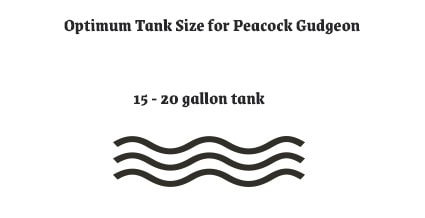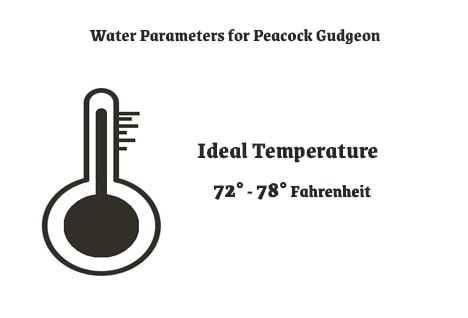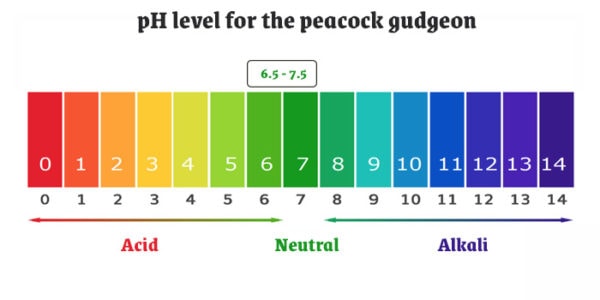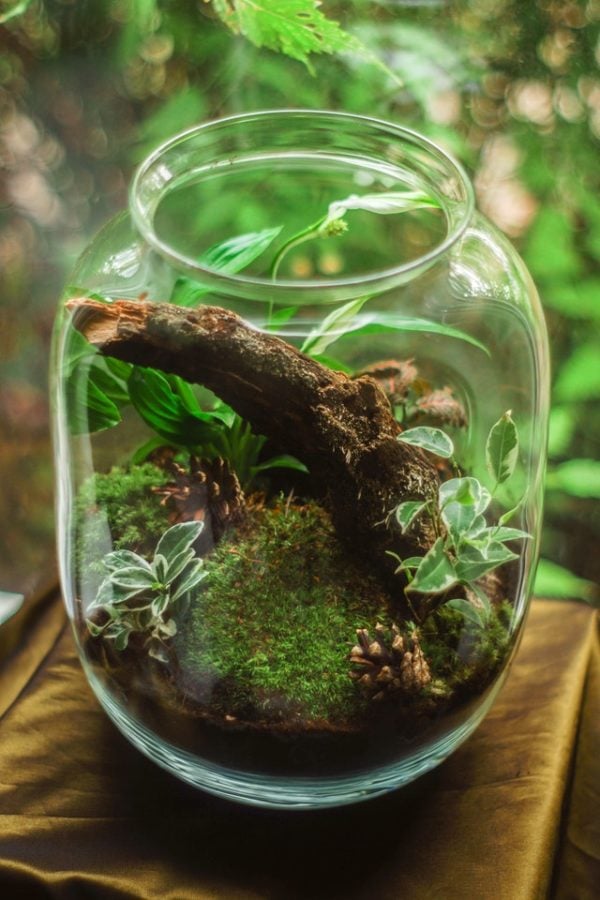One of the fish that stands out whenever you look at a group of fish in an aquarium is the Peacock Gudgeon. This is a credit to the fact that it is an extremely beautiful fish that has smart and vivid coloring. Not only their appearance makes them attractive, but also their nature. They have very distinct and fun personalities that make them stand out in any aquarium and make them a must-have for any aquarist.
Scientifically, it has been named the Tateurndina ocellicauda and is also commonly known as the peacock goby. The peacock gudgeon is a tropical freshwater fish that belongs to the Eleotridae family that is endemic to the eastern and southeastern part of the Papua New Guinea island but is also found in certain locations of Australia and New Zealand.
| Information Chart: | Peacock Gudgeon |
| Scientific Name | Tateurndina Ocellicauda |
| Family | Eleotridae Family |
| Care Level | Very Easy |
| Temperament | Very Peaceful |
| Colour | Black, Red, White, or a combination of these |
| Lifespan | 4 to 5 years |
| Size | Between 1 to 3 inches |
| Diet | Omnivorous Diet |
| Minimum Tank Size | At least 15 gallons |
| Temperature | Between 72 and 79 degrees Fahrenheit (22 to 26 degrees Centigrade) |
| Water conditions | pH level should ideally lie between 6.5 to 7.5 (Soft and slightly acidic) |
| Tank Mate Compatibility | Compatible with other peaceful fish |
| Preferred Tank Set-Up | Lots of hardy plants, a dark sand substrate, rocks and driftwood, caves if possible |
| Sexual Dimorphism | The males are much larger and more colorful. They develop longer dorsal/anal fins, and a nuchal hump when in spawning conditions. The younger females develop black bars along with the dorsal and anal fins that are absent in males. |
| Lighting | Dimly Lit |
Table of Contents
Peacock Gudgeon: A Quick Overview
The Peacock Gudgeon (Tateurndina ocellicauda) is a small, brightly colored fish native to Papua New Guinea. It is a popular aquarium fish due to its vibrant colors and peaceful nature.
About Peacock Gudgeon
Peacock Gudgeon Appearance

This fish has been aptly named after the bird with very a colorful and vibrant appearance as it also has a very bold and striking presence in the water. Just like the peacock, the peacock gudgeon also sports multiple patterns and colors all over its tiny body, including the signature eyespot that is always seen on a peacock.
It is a very colorful freshwater carp gudgeon that boasts a blueish–silver body with multiple black and yellow marks across the body and fins. On the sides of its body, there are red lateral and dotted stripes with a yellow abdomen.
As mentioned earlier, they are sometimes called peacock goby’s as well. However, they are not true goby’s. This is because they do not have the fused pectoral fins that are the mark of a true goby. Apart from the aforementioned black stripes that are present in females and the forehead hump in males, the males and females can also be distinguished based on the obvious difference in length.
The lifespan of a Peacock Gudgeon
The typical lifespan of a Peacock Gudgeon is about 4 to 5 years.
In good conditions, the Peacock Gudgeon typically lives between 4 to 5 years in captivity. While it certainly is not the longest lifespan among freshwater fish, these fish will certainly make the most of their time in your aquarium.
Peacock Gudgeon Size
The typical Peacock Gudgeon will typically grow up to an inch on the lower end and three inches in the case of a larger specimen.
The peacock gudgeon is not a very large fish and is usually seen to grow to a size that lies between 1.5 to 3 inches long. The females usually don’t grow beyond 2.5 inches while males can grow up to 3 inches.
Natural Habitat and Origin of the Peacock Gudgeon
The peacock gudgeon is a fish that is endemic to the east and southeastern part of the island of Papua New Guinea. It does have traces in and around the Australian and New Zealand coast, but its roots have been traced back to Papua New Guinea. Its natural habitat is in the shallow or slow lentic waters of rivers, ponds, and streams. It is mostly found in tropical ponds where it dwells in shallow waters.
Peacock Gudgeon Care and Tank Set-Up
Peacock Gudgeon Tank Size and Specifications
Optimum Tank Size for Peacock Gudgeon

The recommended tank size for peacock gudgeons is 24 inches long, 12 inches wide, and 12 inches tall.
The recommended tank size for Peacock Gudgeon is a 15-gallon tank, assuming you are not going to be keeping more than 6 of them together. People might argue that a 10-inch tank is large enough for them, but our recommendation is a 15-gallon tank. They don’t require a lot of space and neither do they swim around a lot. However, just the 5 extra gallons of water goes a long way and keeps the fish happy.
Filter type
Peacock Gudgeons as fish do not have a specific filter requirement. It is however important that the filter used can thoroughly circulate the water and make sure the nitrate levels are kept low. Another important aspect to keep in mind is the fact that the peacock gudgeon is a very slow fish. This means that the filter or pump used must be kept at the minimum setting in terms of water flow. The use of very powerful pumps and bladders is also a strict no-no. The recommended way to counter this is to break the current that is produced by the filter or bladder. A simple solution to this is to simply direct the pump flow onto the tank glass or by blocking the flow with decorative items.
Substrate
The peacock gudgeon generally prefers darker substrates over lighter tones. This also helps highlight the vibrant striking color that the fish carries. Dark sand substrates are ideal for the peacock gudgeon as it imitates the natural environment that they are used to being in. Moreover, sand is far safer for the peacock gudgeon as it is a small fish that is not very strong.
How many Peacock Gudgeons can be kept in a 10-gallon tank?
Our personal opinion would be to keep no more than 6 peacock gudgeons in a 10-gallon tank. We would recommend a 15-gallon tank for 6 of them, but since they do not swim a lot, some people say that a 10-gallon tank is fine.
Water Parameters for Peacock Gudgeon
Water Temperature

The ideal temperature for Peacock Gudgeons is between 72 and 78 degrees Fahrenheit (22 to 26 degrees Centigrade)
The temperature that the peacock gudgeon thrives in is usually in the range of 72 to 78 degrees Fahrenheit. This is pretty much the temperature that they experience in their natural habitat of the Island of Papua New Guinea.
Water Flow Rate
The ideal water flow rate for peacock gudgeons is the minimal possible setting that the pump offers.
The peacock gudgeon is not a very strong swimmer. Therefore, it needs a low water flow rate to keep the current to a minimum. The best way to deflect and reduce this current is by directing the flow right at the tank glass.
pH Level

The perfect water pH level for the peacock gudgeon is between 6.5 and 7.5
The peacock gudgeon is a fish that prefers a soft to slightly acidic pH level in the water.
Water Hardness
The peacock gudgeon prefers the water that it lives in to be soft and may be slightly acidic. It is quite a sensitive fish.
Peacock Gudgeon Tank Landscape
In terms of habitat, the peacock gudgeons prefer a lush and very decorative aquarium as that is what their original habitat is like in the streams and ponds of Oceania. The peacock gudgeon thrives in plant-rich environments.
Best plants for Peacock Gudgeon Tanks

There are loads of plants you could choose to place inside the tank for peacock gudgeons. As mentioned beforehand, the peacock gudgeon prefers a very plant-rich environment. It is a good idea to choose rough and tough plants that are hardy. Some of the plants that you could opt for placing in the tank with peacock gudgeons are anubias, Java fern, java moss, and water wisteria.
Worst Plants for Peacock Gudgeon Tanks
The selection of plants for a tank that is to meant house peacock gudgeons is a simple task as long as the research is done beforehand. The plants that peacock gudgeons should not be surrounded with are delicate and cannot withstand much abuse. This is because peacock gudgeons like to swim around a lot and interact with the plants that surround them. This leads to wear and tear of the plants thereby making delicate ornamental plants a bad idea. We would not recommend anything apart from hardy plants like anubias, java ferns, java moss, and water wisteria for your aquarium.
Decorations for Peacock Gudgeon Tanks
The first thing that should be done for a tank that will house peacock gudgeons is to establish a dark sandy substrate at the bottom. This will also highlight the bright and vibrant colors of the fish. Next, populate the tank with lots and lots of foliage (plants). These fish love being around plants and interacting with them. Including some rocks and driftwood in your aquarium is a good idea. This will give the fish multiple hiding spots that they would love to explore. Make sure you include some sort of cave in the tank as well. The cave will serve as a potential breeding area or a nest if need be.
Lighting for Peacock Gudgeon Tanks
The lighting in the tank must not be too bright. The peacock gudgeon doesn’t prefer to have its dwelling be bright and striking like its appearance. In fact, keeping the tank dimly lit is a good idea as the fish prefer it to be so. A single small lamp inside the tank should do the trick at night. Else, you could use a lamp with adjustable intensity and vary it through the day. Another option is to control the lighting of your house by adjusting the artificial light sources.
Nitrogen and other requirements for a Peacock Gudgeon fish tank
The concentration of ammonia and nitrites in the water sees a sharp increase when fish in the tank produce waste. This accumulation of chemicals in your tank is hazardous to the fish. These chemicals need to be neutralized to maintain the quality of water in your tank and keep it in a hospitable environment. On average, the nitrogen cycle can take anywhere from 2 weeks to 2 months to be completed in the tank. Once the waste decomposes, the ammonia levels increase until they peak and then start to decline. Now, the nitrate oxidizes the ammonia and leads to the formation of nitrite.
Feeding Peacock Gudgeons
Best Diet for Peacock Gudgeons
As fish, peacock gudgeons are very picky eaters at times. They do not like flake food at all. In fact, a lot of owners have said that they turn their noses up when given flake food. They demand a slightly fancier diet than food pellets or food flakes. Peacock Gudgeons prefer food that is rich in protein and can be preyed upon. Foods like insects, larvae, and other critters that can be hunted or preyed upon are stimulants of their natural habitat.
Adding protein-rich frozen foods mixed with certain live foods like bloodworm, brine shrimp, and daphnia is enjoyed by the fish. The fish are also seen to exhibit brighter and more vibrant colors when they eat healthier food. S
How often should you feed Peacock Gudgeons?
Peacock Gudgeons should typically be fed at least once a day. There have been extreme cases where they have survived without food for 5 to 12 days, but that is not a healthy practice.
Peacock Gudgeon Behaviour and Temperament
Are Peacock Gudgeon Lone or societal in nature?
The peacock Gudgeon is an extremely social fish that participates actively in maintaining the harmony found in the tank. They are known to generally be a peaceful community member that generally does not stir up any conflict. There may be the occasional kerfuffle between two males but temperatures don’t take too long to cool down. They thrive in groups of 6 to 8 but will do just fine even in a pair. Just make sure they have at least one buddy at all times.
It has often been termed that hobbyists love to watch these fish just swim around as they are very lively. The way they interact with their surroundings is interesting and watching them just swim around with their vibrant colors is very satisfying.
Peacock Gudgeon Tank Mates
Ideal Peacock Gudgeon Tank Mates
The Tateurndina ocellicauda is an excellent community fish as it is generally a calm and peaceful fish that will not disturb its smaller tank mates. They can also be kept with other territorial species as long as there is enough space present in the tank. Also, avoid keeping larger fish as tank mates as the peacock gudgeon could potentially be eaten. A list of good tank mates that the peacock gudgeon would be compatible with is given below :
- Dwarf cichlids
- Celestial Pearl Danios
- Cory Catfish
- Ember tetras or other tetras
- Cherry Barb
- Ghost Shrimp
- Harlequin Rasbora
- Bumblebee Goby
- Kuhli Loach
- Apistogramma
There are no specifically bad tank mates for Peacock Gudgeon. Just keep in mind that you should avoid any fish that are much larger or much smaller than the Peacock Gudgeon.
Breeding Peacock Gudgeons
The Peacock Gudgeon makes for quite an interesting breeding project in a home aquarium. Compatible pairs are usually formed in larger groups. The fish are brought together in the breeding condition by providing them with meaty, fatty, and protein-rich foods that could either be frozen or live.
An absolutely essential part of the breeding process that cannot be overlooked is the presence of structures like caves that give these fish an area to breed. These caves can also be made from various items like PVC pipes, bamboo, coconut shells, and other items like rocks if not found in a store.
Male fish will display themselves and their prowess at the entrance to caves by flaring their fins at passing females to try and lure them into the cave. If the male is successful, the female will enter the cave with him and lay her eggs on the ceiling while the male fertilizes them simultaneously. Once the female is done laying the eggs, the male will force her out of the cave and take care of the fertilized eggs until they hatch. About 36 hours after they are hatched, the father stops caring for them.
Peacock Gudgeon Breeding Level – Easy
Sexual Dimorphism
To distinguish between male and female Peacock Gudgeons we first look at the obvious size difference. The males are larger than the females. At their largest, females can grow up to maybe 2.5 inches while males reach 3 inches long. The males are also more colorful. They develop longer dorsal/anal fins, and a nuchal hump when in spawning conditions. The younger females develop black bars along with the dorsal and anal fins that are absent in males.
Peacock Gudgeon Common Diseases and their Treatments
The various diseases like white spot disease, marine white spot disease, anchor worms, gill or skin worms, anchor worms, head hole disease, velvet, sea, dropsy, and tuberculosis are mainly caused due to fungi and parasites. They even suffer from a prevalent condition called Ich or Ick. Let us take a look at some of them.
1. Ich
Like a lot of other fish, the Peacock Gudgeon is also susceptible to ich. It is caused by an ectoparasite called Ichthyophthirius multifiliis which is present in freshwater. The first thing to do when you discover it in your tank is to first quarantine all the other fish as well. Next, you can start treating them with copper-based medicines.
2. Hole in Head disease
This is a disease that affects peacock gudgeons and is transmitted through feces. They are more vulnerable to this disease when in poor water conditions or when stressed. It results in sores and a visible hole in the head. The first line of treatment is to treat the water and make it hospitable.
3. Skin and gill Flukes
Skin and gill flukes are yet another disease that is seen in Peacock Gudgeons when the water conditions are poor. It is caused by Trematodes and can leave severe skin damage if not taken care of properly.
Facts About Peacock Gudgeons
- It is a part of the eliotridae family
- It is sometimes also called a peacock goby
- However, it is not a real goby as it doesn’t have fused pectoral fins
- It is named after the peacock because of its vibrant colors and trademark peacock eye mark
- The female peacock gudgeons do not carry the eggs
Are Peacock Gudgeons right for you?
If you are a newbie in the world of fishkeeping, then these are a pretty good starter fish. They are relatively easy to care for and can really brighten up the tank with their presence. Although they can be slightly picky eaters, apart from their diet, taking care of them should be a walk in the park. If you set up the tank properly and manage to keep the water conditions up to the mark, there should not be too much of a hassle.
Frequently Asked Questions
The best substrate for peacock gudgeons would be a dark sand substrate.
Peacock gudgeons typically live for 4 – 5 years.
No, they usually tend to care for them until they can somewhat fend for themselves.
Peacock gudgeons are slightly fussy eaters and will tend to eat more live or frozen protein and fat-rich foods rather than food pellets and flakes.
Conclusion
Now that you have read all about them, what are you waiting for? They are a perfect addition to your aquarium! They are beautiful, easy to care for, and a delight to observe. Keep them in your tank and we are sure you won’t regret it.
No related posts.
